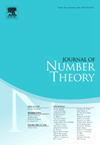The square-root law does not hold in the presence of zero divisors
IF 0.7
3区 数学
Q3 MATHEMATICS
引用次数: 0
Abstract
Let R be a finite ring (with identity, not necessarily commutative) and define the paraboloid . Suppose that for a sequence of finite rings of size tending to infinity, the Fourier transform of P satisfies a square-root law of the form for all nontrivial additive characters ψ, with C some fixed constant (for instance, if R is a finite field, this bound will be satisfied with ). Then all but finitely many of the rings are fields.
Most of our argument works in greater generality: let f be a polynomial with integer coefficients in variables, with a fixed order of variable multiplications (so that it defines a function even when R is noncommutative), and set . If (for a sequence of finite rings of size tending to infinity) we have a square root law for the Fourier transform of , then all but finitely many of the rings are fields or matrix rings of small dimension. We also describe how our techniques can establish that certain varieties do not satisfy a square root law even over finite fields.
在除数为零的情况下,平方根定律不成立
设R是一个有限环(有恒等,不一定交换),定义抛物面P={(x1,…,xd)∈Rd|xd=x12+…+xd−12}。假设对于一个大小趋近于无穷的有限环序列,P的傅里叶变换满足一个平方根定律,对于所有非平凡的可加性字符ψ,其形式为|P φ (ψ)|≤C|R|−d|P|12,且C为固定常数(例如,如果R是一个有限域,则该界满足C=1)。那么几乎所有的环都是场。我们的大多数论证都适用于更广泛的情况:设f是一个具有d−1个变量的整数系数的多项式,具有固定的变量乘法顺序(因此它定义了一个函数Rd−1→R,即使R是不可交换的),并且设Vf={(x1,…,xd)∈Rd|xd=f(x1,…,xd - 1)}。如果(对于大小趋近于无穷大的有限环序列)我们有Vf的傅里叶变换的平方根定律,那么除了有限多个环外,所有环都是小维的场或矩阵环。我们还描述了我们的技术如何能够确定某些品种即使在有限域上也不满足平方根定律。
本文章由计算机程序翻译,如有差异,请以英文原文为准。
求助全文
约1分钟内获得全文
求助全文
来源期刊

Journal of Number Theory
数学-数学
CiteScore
1.30
自引率
14.30%
发文量
122
审稿时长
16 weeks
期刊介绍:
The Journal of Number Theory (JNT) features selected research articles that represent the broad spectrum of interest in contemporary number theory and allied areas. A valuable resource for mathematicians, the journal provides an international forum for the publication of original research in this field.
The Journal of Number Theory is encouraging submissions of quality, long articles where most or all of the technical details are included. The journal now considers and welcomes also papers in Computational Number Theory.
Starting in May 2019, JNT will have a new format with 3 sections:
JNT Prime targets (possibly very long with complete proofs) high impact papers. Articles published in this section will be granted 1 year promotional open access.
JNT General Section is for shorter papers. We particularly encourage submission from junior researchers. Every attempt will be made to expedite the review process for such submissions.
Computational JNT . This section aims to provide a forum to disseminate contributions which make significant use of computer calculations to derive novel number theoretic results. There will be an online repository where supplementary codes and data can be stored.
 求助内容:
求助内容: 应助结果提醒方式:
应助结果提醒方式:


